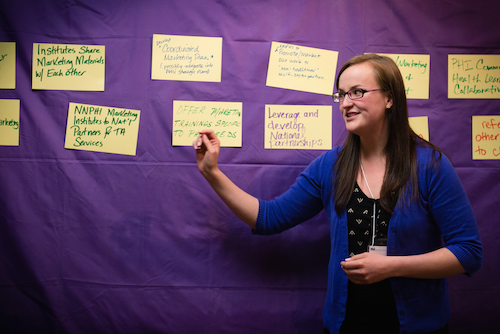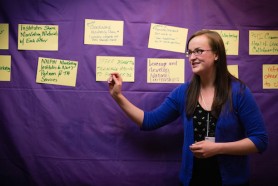Our “Distributed Capacity” and our Work Together as a Network
- By: Multiple Authors
- Date
 The NNPHI network is an interconnected system of organizations growing and evolving towards a shared mission: improving health in the places where we live, work, and play.
The NNPHI network is an interconnected system of organizations growing and evolving towards a shared mission: improving health in the places where we live, work, and play.
As a matter of practice, NNPHI and its member institutes team up to support the kind of systemic public health improvements that our communities can see and feel; as we pull local resources, assets, and strengths to address national public health priorities.
What is a distributed capacity network?
The NNPHI network is evolving into what we call a distributed capacity network. To meet shared objectives and to implement shared strategies. Our members know that they can lean on us and each other for expertise and other specialized support.
So what does a distributed capacity network look like in action?
Say for example a national health funder invites a public health institute to apply for a limited competition grant to run a national program office focused on enhancing communities’ use of data to improve health. Recognizing our network’s distributed capacity, the public health institute knows it can rely on NNPHI and peer institutes to strengthen its proposal and eventually the implementation of the work. In consultation with the public health institute, NNPHI recommends a partnership with a peer institute to leverage specific skills and competencies that will strengthen its distributed approach. As a result the proposal with two public health institutes collaborating to leverage their respective strengths, is funded. In addition, NNPHI assists the institutes in publicizing the national program, Data Across Sectors for Health (DASH), while leveraging the broader network for implementation.
Our journey to the “distributed capacity” concept
NNPHI worked with the Bridgespan Group to examine the evolving public health infrastructure. Through this process, NNPHI identified a spectacular wide range of capacities and expertise across our membership network.
Paralleling this work is the rising movement to implement standards of public health agency accreditation and define the foundational capabilities of public health. As part of the public health system, and in service of these efforts, NNPHI’s member institutes want to understand how other organizations are pooling and sharing capacity and competencies.
We are interested in learning how models for distributed capacity across government agencies may be applied to our network, so we are also leveraging the skills and capacities of the Kansas Health Institute (KHI) to benefit the larger network.
KHI has lead explorations and evaluations of how governmental public health agencies share knowledge and resources across their organizational structures and jurisdictions. Their tagline for this initiative is “Rethinking Boundaries for Better Health”. While NNPHI’s member institutes don’t need or aren’t required to have the same capacities across all states as is the case for government agencies, they have demonstrated a willingness to share knowledge and resources with one another. KHI’s Center for Sharing Public Health Services has published a case study of a regional health district that has been able to leverage a number of grants and contracts that the individual towns wouldn’t have been able to do on their own. Public health institutes working together have demonstrated a similar capacity to leverage grants and contracts, as referenced in the earlier example (DASH).
NNPHI’s role in the distributed capacity network
Given our expansive and evolving field and network, NNPHI—as an organization with offices in brick-and-mortar and offices in New Orleans and Washington—can be challenged in sharing tidy explanations of our breadth and depth.
We respond to the needs of our members, but we want to avoid reactionary solutions that address only the immediate challenges of individual member institutes.
We want to pool resources and leverage shared strengths, but we understand the competitive realities of business development and grant-making.
We champion public health innovations, but we know those innovations are necessarily disruptive to the field and our work because it’s the only way to advance them both.
We take great pride in uniting and amplifying the dynamic expertise of public health institutes across the country, but we also know that uniting a broader range fields and disciplines is the present and future of public health practice.
In light of these issues, NNPHI can be considered the flexible backbone—the support—of our ever-evolving distributed capacity network, which means we must continue to offer an evolving and diverse menu of capacities, capabilities, and subject matter expertise for our members.
Our favorite moments of collaborative work
We thrive on convening, organizing, managing, and facilitating strategic development in collaboration with member institutes, but we continue to explore what this means for network engagement and growth. Where can we witness the impact of the distributed capacity model in our network?
Here are three of our favorite, recent examples of when NNPHI shined a light on the strategic possibilities of our distributed capacity network.
County Health Rankings and Roadmaps (CHR&R): NNPHI has connected the University of Wisconsin Population Health Institute with thirteen public health institutes across the nation to rollout the annual rankings over the past few years. NNPHI also recently hired seven community coaches to provide technical assistance to communities interested in utilizing CHR&R for health improvement. The public health institutes helped with dissemination at the state level; NNPHI provided a nimble mechanism for hiring and standing up the coaches. As a result of this approach, the CHR&R has much broader reach into communities across the nation.
Health Impact Assessments: NNPHI has co-hosted several national health impact assessment meetings in collaboration with the Health Impact Project at The Pew Charitable Trusts. NNPHI has also worked with two public health institutes to serve as leaders in providing HIA technical assistance to federal agencies. At the state and local level, more than 10 public health institutes are conducting HIAs, providing training and technical assistance. As a result, the use of HIA is increasing steadily across the nation.
Local Policy Database Scan and Defining Healthy Communities: Funded by CDC through a cooperative agreement with NNPHI, this collaborative project led by Illinois Public Health Institute documented the landscape of local policy databases that support healthy communities and recommends options for the potential development of a future national database. Illinois Public Health Institute did project management and information technology requirements analysis, Texas Health Institute conducted an online survey of end users of local policy databases, Mississippi Public Health Institute conducted key informant interviews. The final report confirms a lack of any comprehensive national-level database containing local, healthy communities’ policies and proposed conditions under which such a system might be created. While the definition of healthy communities is evolving, most current policy databases do not reflect the increasing interest in quantitative analysis and policy impact, or the increasing emphasis on public health systems and social determinants of health. Recommendations include creating a forum and process for establishing standards and common criteria for policy databases, and leveraging desirable features of existing databases and tools. While existing databases might be leveraged for future replication, the current interests of practitioners and researchers may require the creation of new models. A framework for evaluating these options is proposed (see current report).
We would love to hear some of the collaborative work your institute in doing. Please share your comments below.
Authors:
Christopher Kinabrew, MPH, MSW
Michael Spencer is a graduate student intern with NNPHI and pursuing a double masters degree in Public Health and Social Work at Tulane University.
Brittany Bunn is an NNPHI program assistant supporting workforce development activities, convenings, and communications.

 Subscribe To Our Communications
Subscribe To Our Communications